Explore the Colossi of Memnon, Two Giant Statues of Ancient Egypt
The mysteries of ancient Egypt continue to captivate us, even today. One such wonder that draws tourists worldwide is the Colossi of Memnon - two giant statues that stand tall in Luxor, Egypt. These magnificent statues were built almost 3,500 years ago to guard the temple of King Amenhotep III and have withstood the test of time, surviving earthquakes, floods and other calamities. Standing over 60 feet, these colossal statues fascinate visitors with intricate carvings and elaborate facial features. Join us as we explore the history, myth and legends surrounding the Colossi of Memnon.
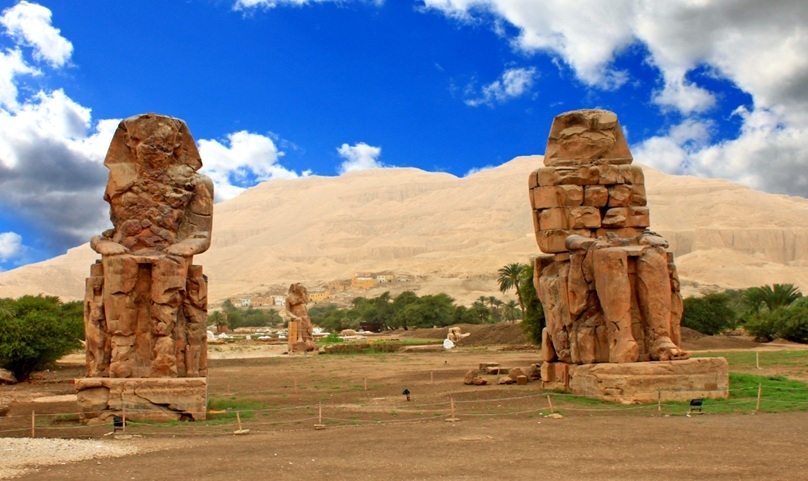
A brief explanation of Colossi of Memnon
The Colossi of Memnon are two giant statues on the outskirts of Luxor, Egypt. Built in 1350 BC, these statues were designed to guard the tomb of King Amenhotep III in what was then the largest temple in ancient Egypt. Although the temple was destroyed in 1200 BC, the statues remained.
They stand 20 meters tall each, weighing around 650 metric tons each. The northern statue of the two is famous for its "song," which was attributed to African King Memnon and is said to be heard at sunrise. According to legend, hearing the statue's song is considered good luck.
The Colossi are situated on the west bank of the Nile River, opposite modern-day Luxor. Although the statues are quite damaged today, they remain a must-see site for tourists visiting Egypt.
If you're interested in ancient Egyptian history, the Colossi of Memnon are worth exploring. The ancient Greeks and Romans were enchanted by these magnificent works of art, and they continue to captivate visitors to Egypt today.
So, go ahead and visit the Colossi of Memnon to experience the magic and wonder of ancient Egypt! [1][2]

Built to guard the tomb of King Amenhotep III
The Colossi of Memnon serve as a testament to the impressive engineering feats of ancient Egypt. These two giant statues, towering at 60 feet tall and weighing an estimated 720 tons each, were built in 1350 BC to guard the tomb of Pharaoh Amenhotep III.
The complex, which was once the largest on the west bank of the Nile, is still being excavated by archaeologists. While the temple complex has been largely destroyed and lost to the ages, the Colossi still stand tall, reminding us of the might and power of ancient Egypt.
It's awe-inspiring to imagine how these colossal statues were carved from sandstone from quarries near Aswan and then transported by land over 400 miles to their final location on the outskirts of Luxor. These structures have withstood earthquakes and the ravages of time, attracting countless visitors from around the world who come to marvel at their size and beauty.
If you're planning a trip to Egypt, visit the Colossi of Memnon and witness firsthand the legacy of this ancient civilization. [3][4]

Constructed in 1350 BC
The Colossi of Memnon are imposing statues that stand tall on the outskirts of Luxor, Egypt. These giant figures were constructed around 1350 BC and are said to be among the most iconic remnants of ancient Egypt.
Originally built to guard the tomb of King Amenhotep III, the Colossi of Memnon stand at an impressive height of 20 meters, or 60 feet tall. Each statue weighs around 650 metric tons and is made of sandstone quarried at Gebel el-Silsila, south of Aswan. Although a temple complex once surrounded these statues, an earthquake around 1200 BC destroyed the temple but left these giant statues standing.
Despite the damages from earthquakes and time, the Colossi of Memnon remain a famous tourist attraction for visitors seeking to experience ancient history first-hand. The statues are a testament to the remarkable construction abilities of the ancient Egyptians, who could create such massive structures without modern technology.
A visit to the Colossi of Memnon should be on every traveller's list, as it is an opportunity to witness an awe-inspiring piece of history. [5][6]
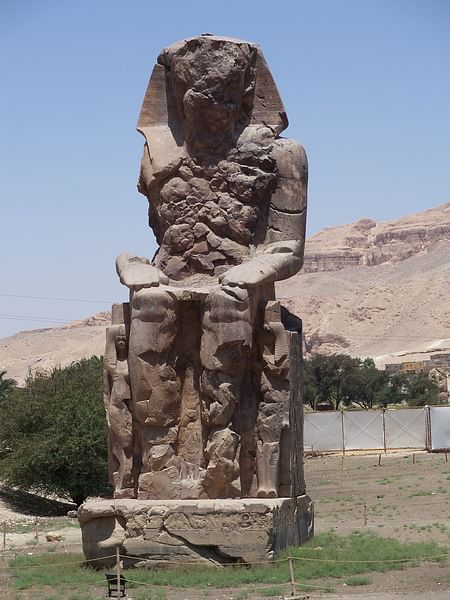
Temple was destroyed in 1200 BC, and statues remained
Despite being built to guard the tomb of King Amenhotep III, the temple where the colossal statues of the king were located was destroyed in 1200 BC due to a powerful earthquake. However, the statues remained intact and proud, standing tall on the outskirts of Luxor as a testimony to ancient engineering and artistry.
The earthquake also opened numerous chasms in the ground, resulting in many statues being buried in pristine condition. Since then, the Colossi of Memnon have become a popular tourist attraction, with visitors coming from all over the world to witness their grandeur and learn about their history.
Before being destroyed, the temple complex was the largest and most opulent in Egypt, covering 35 hectares (86 acres). Today, very little remains of Amenhotep's temple, except for these two giants that continue to amaze and inspire people from all walks of life.
So, if you're planning a trip to Luxor, don't miss the chance to explore the Colossi of Memnon and discover the secrets behind these awe-inspiring statues that have stood the test of time. [7][8]
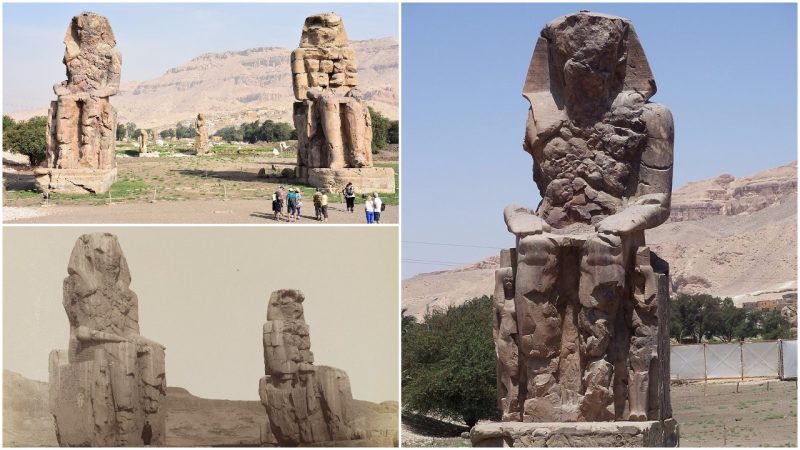
Two giant statues standing 20 meters (60 feet) tall each
The Colossi of Memnon stand majestically on the outskirts of Luxor, Egypt, and have captivated visitors for over a thousand years. These giant statues, standing at an impressive 20 meters (60 feet) tall each, are truly a sight to behold. Built-in 1350 BC to guard the tomb of King Amenhotep III, these statues are estimated to weigh around 650 metric tons each.
Despite the main temple being destroyed in 1200 BC, the Colossi of Memnon remains standing today. Legend states that the northern statue whistles at sunrise, attributed to the African King Memnon. It is believed that hearing this whistle is a sign of good luck. These remarkable statues are usually included on guided tours of the area.
Visitors are welcome to take photographs of the statues, with the mountains and desert in the background adding to the incredible landscape. The Colossi of Memnon are an important piece of ancient Egyptian history and culture worth visiting.
So, if you’re planning a trip to Luxor, add these impressive statues to your list of must-see destinations! [9][10]
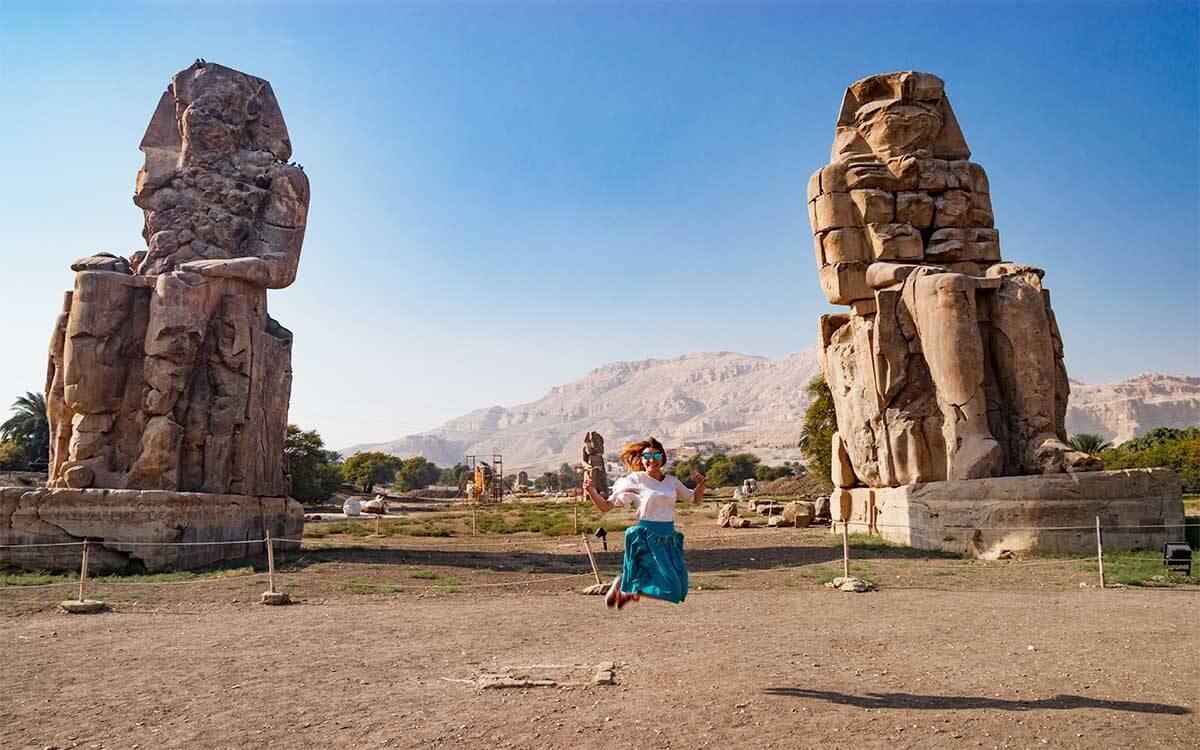
Estimated to weigh around 650 metric tons each
Standing before the Colossi of Memnon, you are awed by their size and grandeur. These two enormous statues, towering 60 feet above the ground, are estimated to weigh around 650 metric tons each. To put that in perspective, that's about the weight of 70 elephants!
It's hard to imagine how the ancient Egyptians could carve such massive statues from sandstone and transport them over 400 miles to their current location in Luxor.
Today, visitors come from all over the world to marvel at the Colossi of Memnon, to take photos with them, and to listen for the legendary "song" of the northern statue at sunrise. It's no wonder that these ancient wonders have captivated the imagination of people for thousands of years and continue to do so today.
If you have the opportunity to visit them, don't miss out! [11][12]

Situated on the outskirts of Luxor
The Colossi of Memnon, situated on the outskirts of Luxor, offer a peaceful and serene setting away from the hustle and bustle of the city center. These ancient statues stand tall against the backdrop of the mountains and desert, creating a picturesque location for photography enthusiasts.
Easily accessible, you can find a driver to take you to the Colossi and other West Bank sites, or your hotel can typically arrange transportation. If you prefer to skip the hassle of organizing everything yourself, several companies provide tours to the Colossi and other Luxor sights.
While visiting the statues, be sure not to miss listening out for the legend of the northern statue that whistles at sunrise. This intriguing phenomenon is attributed to the African King Memnon and is considered a sign of good luck if you hear the statue's song.
Visiting the Colossi of Memnon is a unique and rewarding experience that shouldn't be missed by anyone travelling to Luxor, Egypt. [13][14]
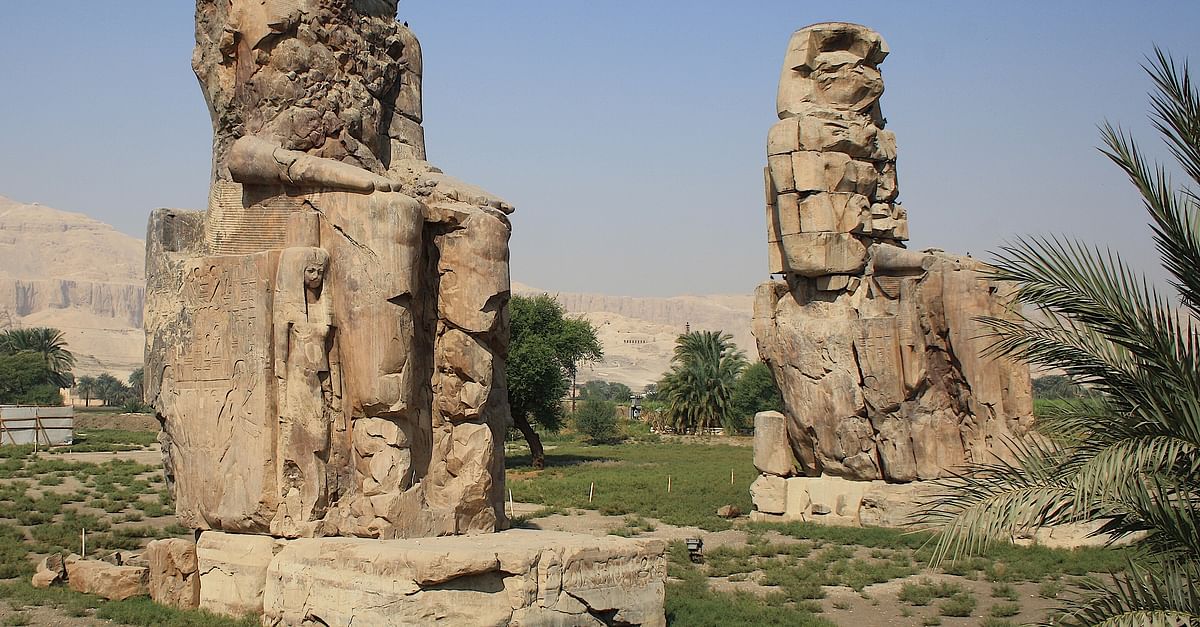
Legend of northern statue whistling at sunrise
One of the most intriguing aspects of the Colossi of Memnon is the legend surrounding the northern statue, which supposedly "sings" at dawn. According to this legend, the statue emits a moaning or whistling sound as the sun rises. While the ancient Greeks and Romans attributed this phenomenon to the grieving mother of the hero Memnon, today, we suspect that it was most likely caused by seismic activity.
Historians believe the statue sustained damage during an earthquake in 27 BCE, leading to its unique vocalization. However, despite the natural explanation for this phenomenon, many still enjoy visiting the Colossi of Memnon, hoping to hear the statue's song. It's even considered good luck to hear it!
Whether you believe in the legend or not, there's no denying that these colossal statues are a sight to behold. So why not see them for yourself and explore the incredible history of ancient Egypt? [15][16]
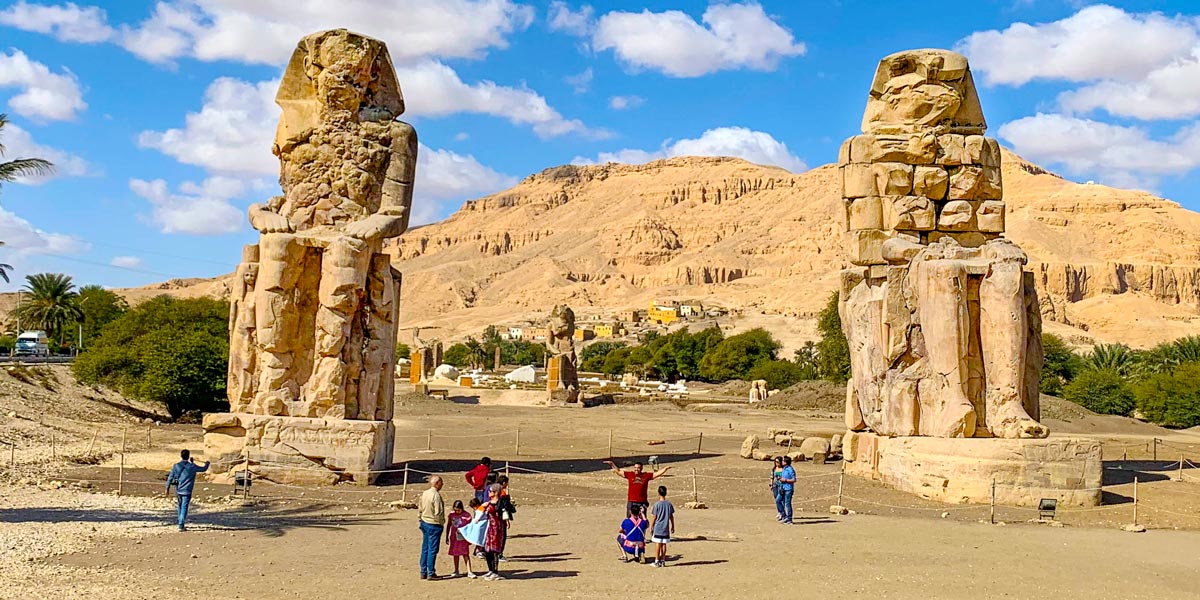
Attributed to African King Memnon
Legend has it that the northern statue of the Colossi of Memnon would whistle at sunrise. The ancient Greeks and Romans attributed this to the African King Memnon. Visitors during that time believed it to be a sign of good luck to hear the statue's song, which they interpreted as the king's cry greeting his mother, the goddess of dawn.
This legend has persisted for centuries and added to these impressive statues' mystique and allure. Despite being partially damaged and reconstructed after earthquakes, the Colossi of Memnon remain towering and impressive figures on the outskirts of Luxor.
Visitors can explore the ruined temple they were built to guard and witness the symbols and hieroglyphs of ancient Egypt. Regardless of whether visitors believe the whistling statue's legends, the Colossi of Memnon are undoubtedly important and impressive relics of the ancient world and worth a visit for anyone interested in history or archaeology. [17][18]

Considered good luck to hear the statue's song
Have you heard of the legend behind the Colossi of Memnon? According to ancient Greek and Roman visitors, hearing the northern statue whistle at sunrise was considered a stroke of good luck. This belief was attributed to the African King Memnon. They thought it was the king's cry, greeting his mother, Eos, the goddess of dawn.
The whistling sound, however, is likely due to a crack in the statue's body caused by an earthquake in 27 BCE. Despite the scientific explanation, this legend still captivates tourists and locals alike. Hearing the statue's song is thought to bring positive energy and good fortune.
So why not come and explore the Colossi of Memnon for yourself? These two colossal statues stand 20 meters (60 feet) tall each and weigh around 650 metric tons each. They were built to guard the tomb of King Amenhotep III, and while their mortuary temple was destroyed in 1200 BC, the statues remain.
Situated on the outskirts of Luxor, the Colossi of Memnon is a must-see for any visitor to Egypt. Remember to keep an ear out for the northern statue's song, and who knows, you might just be lucky enough to hear it. [19][20]

Encourage readers to visit and explore.
Visiting the Colossi of Memnon is a once-in-a-lifetime experience that no traveller should miss. Not only will you be able to witness the greatness of ancient Egyptian architecture up close, but you'll also have the opportunity to uncover some remarkable tales and legends associated with these giant statues.
These Colossi stand tall and mighty, and you won't be able to help to feel awed and humbled in their presence. At 60 feet tall, each statue is a mammoth masterpiece that tells a story of a powerful king and his reign. Exploring the site also gives you a unique glimpse into how ancient Egyptians paid respects to their departed rulers.
Furthermore, hearing the northern statue whistle at sunrise can be a truly inspiring moment and possibly a stroke of good luck for those who believe in legends. It's a must-visit destination if you're in Luxor, and the good news is that it's quite easy to get there.
On top of that, several guided tours are available that include the Colossi of Memnon as part of a larger itinerary. So don't hesitate to take advantage of this once-in-a-lifetime opportunity and come and explore the Colossi of Memnon for yourself. You won't regret it! [21][22]
